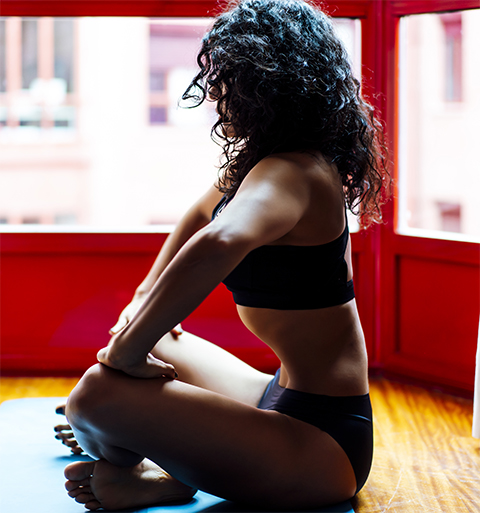
Breathing and not breathing
“Exhale, hold your breath, and apnea,* open your rib cage, lift your rib cage out of your pelvis …”
This may sound a bit like medieval torture, but it’s commonplace cuing for what’s known as low pressure fitness, or LPF, with hypopressive breathing techniques, a form of exercise and wellness that focuses on the core and posture. Hypopressive means decreasing the pressure in your thoracic, abdominal and pelvic regions by controlled holding and release of breath.

I first practiced LPF as part of a hospital-sponsored postpartum exercise class a few months after I gave birth to my daughter. I often fall prey to fitness and exercise fads that never seem to stick, but this seemed like a fun way to get out of the house — and exercising with my baby rolling around on the mat below gave me a thrill. It was a terrific class; the babies were ridiculously cute, testing out smiles, rolls and vocalizations as we stretched, bent and posed above them.
What I most loved, however, was the class’s emphasis. It was not at all about the seemingly unobtainable goal of quickly regaining my prepregnancy body. Instead, the physical therapists who taught the class focused on pelvic floor stability, mobility and health. Low pressure fitness and the cycles of hypopressive breathing were just part of the course, but they were what hooked me.
All my life, I’ve suffered from abdominal cramping, endometriosis and gastrointestinal issues, so I was happy to find a way to control breath and release my abdomen. The hypopressive lift and expansion reduce pressure, the opposite of exercises like situps and crunches that put strain and pressure on the abdomen and pelvis. I had found my niche.
How does it work?
While engaging your posture — sitting up straight — take a big breath in and then slowly release all the air in your lungs. When you feel like a completely deflated balloon, hold your breath and imagine now that you’re taking a “fake breath” — open your rib cage and go through the abdominal motions of breathing without actually inhaling.
This technique, which allows the diaphragm and rib cage to expand, lifting the pelvic floor with it, is not new. According to the teaching site Elevate Core Health, which is led by my postpartum teacher and pelvic health physical therapist, Becky Keller, hypopressive breath training has been around for hundreds of years in conjunction with yoga practices. Body builders such as Arnold Schwarzeneggar have been known to use hypopressives to enhance their poses as they strut their physiques. Low pressure fitness began as a whole-body workout and posture system combining the breath training with often challenging poses and stretches.
Two years after that postpartum class, in the summer of 2021, Becky sent an email announcing that she was offering Zoom-based virtual classes and workshops on low pressure fitness. I decided to jump back in from the comfort of my own home. It was difficult. I hadn’t thought about these techniques, let alone practiced them, since 2019. My arms, back and legs ached a bit afterward.
These moves don’t necessarily raise your heart rate, but the constant apnea cycles combined with total body engagement are definitely an exercise you feel. While the top of your head “grows toward the ceiling” and the shoulder girdle spreads, stretching down your legs to your feet, often standing with a slight lean to activate your core muscles further, you are involving your whole body. Sometimes we use a TheraBand or yoga brick for tension or balance, respectively.
It was hard, but I was a convert. I immediately bought a pack of five online classes to continue my practice. Now, a year and a half later, almost every Sunday I wake up and join Becky’s class for virtual exercise.
Why continue remotely? Becky has opened in-person classes again, and not too far away from my house, but the accessibility of being able to do this at home is key. My motivation to continue practicing has increased because I have the convenience of performing something so complicated very simply in my home. My daughter can sleep in the other room, my husband can go to church and my dog can wander around (putting a smile on my classmates’ faces) as I exercise. I even can go outside on a nice day and set up my computer on the deck. For me, doing something this empowering and fine-tuned while out in nature is an extra perk.
How effective is virtual exercise? With low pressure fitness, as long as your camera captures your full body, it’s remarkable how much the teacher can see. Becky accurately cues, corrects and praises us in small classes of about four students. Low pressure fitness has several ability levels. After being active for the past year and a half, I’ve progressed from beginner to intermediate with my weekly class and two workshops (for deeper focus and skill), graduating from hypopressive breathing accompanying rigid poses into more flow from pose to pose, including asymmetry and dynamic movement. For example, one arm may be up, the other down, and then one leg lunges forward and the hands come to another position or spiral the fingers, opening a fist and engaging the radial nerves through the hands, all while practicing hypopressive breathing.
How do I incorporate this practice into daily life? At the intermediate level, the full sequence of 12 poses, done on both sides for balance (right leg forward and then repeated with left leg forward), takes about 11 minutes if no major variations are added. While Becky’s weekly classes last roughly an hour, including a full warmup and a postexercise mindfulness activity, my daily (or whenever I can fit it in) practice can be much shorter, just hitting the major groups and poses.
What’s the coolest part of LPF? The poses are named after goddesses. Drawing from Greek, Roman, Norse and Egyptian mythology, the colorful names and body positioning often clearly illustrate their symbolism (a warrior, justice, fertility). One subset of LPF uses a wall for posture, and each of those poses takes on the equivalent names of mythological gods. Empowering? Check! I feel a delightful gravitas knowing what “doing a Persephone with a low Athena arm” means — and performing it — channeling these powerful, mythical women.
What benefits can I attest to? I’m not always consistent in my practice, but I do love a challenge. While my core still could use some work, my posture and my minor pelvic floor dysfunction both have improved. And the hypopressive breath training has benefitted me in ways I didn’t anticipate. I recently took up running again — nothing too drastic, too far or too fast — and when I added miles, I found that my body was a bit fatigued but I was not out of breath. This was true every time I ran, even on the hottest of days.
LPF brings me the promise of the goddess, the challenge of the core and an indescribable euphoria that floods my system when I regain breath after holding it with moving, posing and stretching. Such oddly satisfying moments are rare in life, and as I continue my own wellness journey, LPF is here to stay as my method of choice.
Enjoy reading ASBMB Today?
Become a member to receive the print edition four times a year and the digital edition monthly.
Learn moreGet the latest from ASBMB Today
Enter your email address, and we’ll send you a weekly email with recent articles, interviews and more.
Latest in Opinions
Opinions highlights or most popular articles

The tortoise wins: How slowing down saved my Ph.D.
Graduate student Amy Bounds reflects on how slowing down in the lab not only improved her relationship with work but also made her a more productive scientist.

How pediatric cataracts shaped my scientific journey
Undergraduate student Grace Jones shares how she transformed her childhood cataract diagnosis into a scientific purpose. She explores how biochemistry can bring a clearer vision to others, and how personal history can shape discovery.

Debugging my code and teaching with ChatGPT
AI tools like ChatGPT have changed the way an assistant professor teaches and does research. But, he asserts that real growth still comes from struggle, and educators must help students use AI wisely — as scaffolds, not shortcuts.

AI in the lab: The power of smarter questions
An assistant professor discusses AI's evolution from a buzzword to a trusted research partner. It helps streamline reviews, troubleshoot code, save time and spark ideas, but its success relies on combining AI with expertise and critical thinking.

How AlphaFold transformed my classroom into a research lab
A high school science teacher reflects on how AI-integrated technologies help her students ponder realistic research questions with hands-on learning.

Writing with AI turns chaos into clarity
Associate professor shares how generative AI, used as a creative whiteboard, helps scientists refine ideas, structure complexity and sharpen clarity — transforming the messy process of discovery into compelling science writing.

